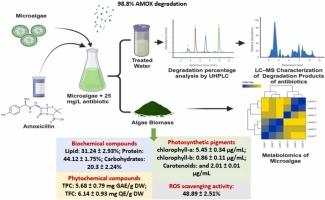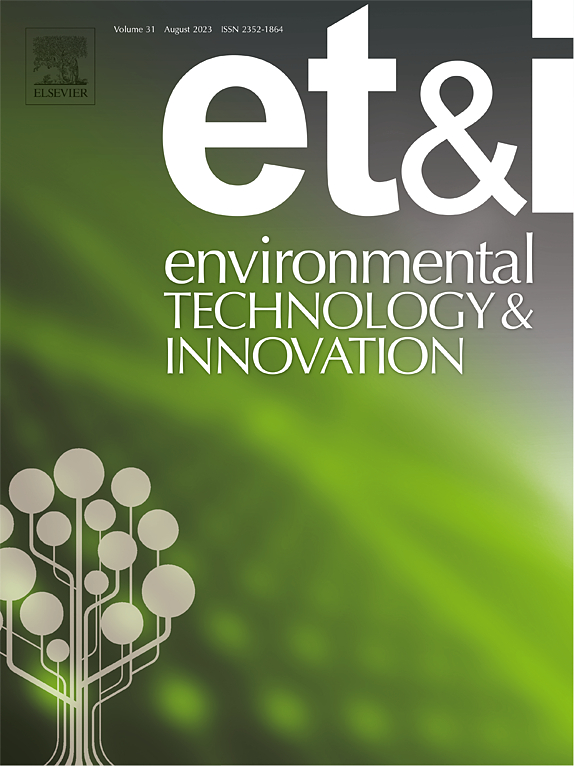微藻介导的生物修复:阿莫西林诱导应激下的代谢组学分析和适应性反应
IF 6.7
2区 环境科学与生态学
Q1 BIOTECHNOLOGY & APPLIED MICROBIOLOGY
引用次数: 0
摘要
本研究考察了不同浓度(25、50、100和150 mg/L)的阿莫西林-3000 (AMOX)(一种广泛使用的β -内酰胺类抗生素)对小球藻sorokiniana uind6生长的影响。结果表明,低浓度(25 mg/L)的AMOX对微藻生长的促进作用最佳,对AMOX降解过程、转化产物鉴定、微藻生化组成等方面进行了进一步探索。研究了直接(光)和间接(微藻诱导)的光降解。LCMS鉴定出两种光降解产物相似,m/z比为367.1。此外,微藻诱导的c光降解在96 h后产生了可忽略的抑制区,达到了令人印象深刻的98.8%的降解,大大超过了单独光降解的85.5%。非生物因子的改变也影响了微藻细胞的化学计量,导致微藻细胞的脂质(31.24±2.93%)和蛋白质(44.12±1.75%)含量显著高于对照细胞(脂质23.6±2.4%,蛋白质31.62±1.52%),表明在amox诱导的应激下,微藻细胞的代谢发生了显著变化(p<0.05)。活性氧(ROS)清除能力增加(48.89±2.51%),表明光合作用受损,TPC和TFC含量降低,有助于预防氧化应激。总的来说,本研究强调了小球藻通过光降解诱导AMOX的生物修复比光驱动过程的优势。它提出了一种实用的、可持续的方法来减轻淡水生态系统中的生态风险,并提供了在环境相关条件下微藻系统中抗生素去除机制和性能的见解。本文章由计算机程序翻译,如有差异,请以英文原文为准。

Microalgae-mediated bioremediation: Metabolomic profiling and Adaptive Responses under Amoxicillin-induced stress
This study examines the effects of varying concentrations (25, 50, 100, and 150 mg/L) of Amoxicillin-3000 (AMOX), a widely prescribed beta-lactam antibiotic, on the growth of the microalga Chlorella sorokiniana UUIND6. Results revealed that low AMOX concentration (25 mg/L) stimulated best algal growth, prompting further exploration of AMOX degradation processes, identification of transformation products, biochemical composition of microalgae. Photodegradation, both direct (light) and indirect (induced by microalgae) was examined. LCMS identified similar transformation product in both the photodegradation with a m/z ratio of 367.1. Moreover, microalgae-induced c photodegradation resulted in negligible zone of inhibition after 96 h, achieving an impressive 98.8% degradation, significantly surpassing the 85.5% degradation observed with light alone. Modifications in abiotic factors also influence the stoichiometry of microalgae cells, resulting in significantly higher lipid (31.24 ± 2.93%) and protein (44.12 ± 1.75%) content compared to control cells (lipid 23.6 ± 2.4%, protein 31.62 ± 1.52%), indicating notable metabolic alterations (p<0.05) under AMOX-induced stress. Additionally, increased reactive oxygen species (ROS) scavenging activity (48.89 ± 2.51%) suggests photosynthetic impairment and a decrease in TPC and TFC content, aiding in the prevention of oxidative stress. Overall, this study highlights the advantages of Chlorella-induced bioremediation of AMOX via photodegradation over light-driven processes. It presents a practical, sustainable approach for mitigating ecological risks in freshwater ecosystems and provides insights into antibiotic removal mechanisms and performance in microalgae-based systems under environmentally relevant conditions.
求助全文
通过发布文献求助,成功后即可免费获取论文全文。
去求助
来源期刊

Environmental Technology & Innovation
Environmental Science-General Environmental Science
CiteScore
14.00
自引率
4.20%
发文量
435
审稿时长
74 days
期刊介绍:
Environmental Technology & Innovation adopts a challenge-oriented approach to solutions by integrating natural sciences to promote a sustainable future. The journal aims to foster the creation and development of innovative products, technologies, and ideas that enhance the environment, with impacts across soil, air, water, and food in rural and urban areas.
As a platform for disseminating scientific evidence for environmental protection and sustainable development, the journal emphasizes fundamental science, methodologies, tools, techniques, and policy considerations. It emphasizes the importance of science and technology in environmental benefits, including smarter, cleaner technologies for environmental protection, more efficient resource processing methods, and the evidence supporting their effectiveness.
 求助内容:
求助内容: 应助结果提醒方式:
应助结果提醒方式:


